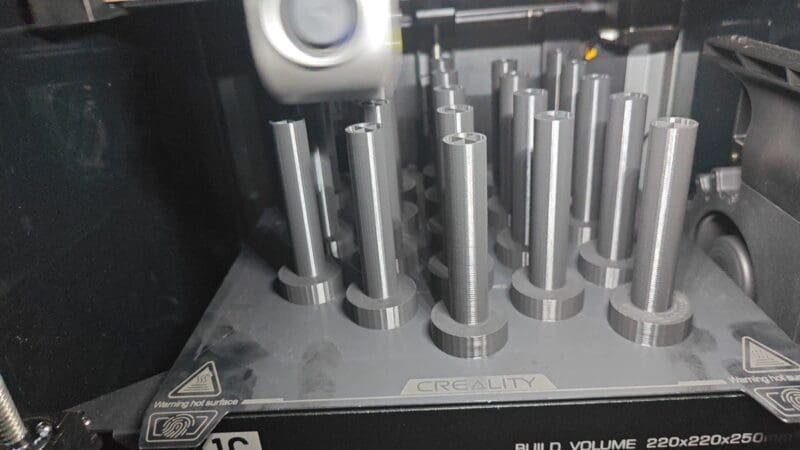Ender 3 pro vs Ender 3 v2: Which one is better?

Introduction
Welcome to the ultimate showdown between the Ender 3 Pro vs Ender 3 V2! If you’re a 3D printing enthusiast, you’ve probably found yourself torn between these two exceptional printers. Both the Ender 3 Pro and the Ender 3 V2 offer reliability, excellent build volume, and compatibility with various filaments. But what sets them apart?
In this article, we’ll dive deep into the subtle contrasts between these printers to help you make an informed decision. We’ll explore their design and build quality, print quality, user interface, bed surface, noise levels, firmware and software, and power supply. By the end, you’ll have a clear understanding of which printer suits your needs best.
Ender 3 pro vs Ender 3 v2
Design and Build Quality
When it comes to design and build quality, both the Ender 3 Pro and Ender 3 V2 showcase their unique attributes. The Ender 3 Pro boasts a practical and sturdy design, with its standout feature being the hefty 40×40 aluminum extrusion for the Y-axis base. This robust construction provides exceptional stability, minimizing print errors caused by vibrations. Additionally, the Ender 3 Pro features a magnetic print bed, exclusive to this model, which allows for easy print removal after completion. The inclusion of a Mean Well UL-certified power supply ensures safe and efficient operation.
On the other hand, the Ender 3 V2 represents an advancement in design with its sleek all-metal body. This updated frame not only enhances durability but also adds an aesthetic appeal to your workspace. The V2 model features a carborundum glass platform, replacing the magnetic bed of the Ender 3 Pro. This upgrade improves adhesion and provides a more accessible printing base. Furthermore, the V2 model includes a hidden power supply, offering a safer and visually pleasing operation experience.
Print Quality
The Ender 3 Pro, with its sturdy build and improved stability, ensures consistent and high-quality prints. The upgraded power supply allows for superior temperature regulation, giving users access to a wide range of filaments for their projects. Additionally, the innovative magnetic print beds produce prints with minimal scuffs on their bottom surfaces, resulting in a smooth finish.
While the Ender 3 V2 takes print quality to the next level. The inclusion of a carborundum glass platform enhances adhesion and provides a more accessible printing base. This, combined with the improved print stability from the all-metal body and the silent stepper motor drivers, results in even smoother finishes with fewer defects. Furthermore, the addition of a rotary knob on the extruder makes filament feeding more straightforward, contributing to overall print quality.
Both printers benefit from a vibrant online community that offers help with troubleshooting, shares printing tips, and provides 3D models for printing. While the Ender 3 Pro has a more established community, the Ender 3 V2’s community is growing rapidly and becoming increasingly resourceful.
User Interface
When it comes to the user interface, the Ender 3 V2 takes the lead with its more advanced and intuitive design. This printer boasts a vibrant color LCD with a responsive touch screen, offering a more modern and user-friendly experience. The color screen enhances usability, allowing for easier navigation and settings adjustments. Plus, the embedded toolbox provides convenient access to tools, making your printing process smoother than ever.
The Ender 3 Pro features a basic knob navigation interface. While it may not have the same visual appeal as the V2, it still offers a user-friendly experience. The classic LCD with a rotary knob allows you to navigate the options and monitor the printing process with ease. Additionally, the Ender 3 Pro supports offline printing using a micro SD card, adding further convenience to your 3D printing journey.
Whether you prefer the sleek touch screen of the Ender 3 V2 or the simplicity of the Ender 3 Pro’s knob navigation, both printers offer a user interface that is intuitive and easy to use. Ultimately, the choice between the two depends on your personal preference and the level of sophistication you desire in your 3D printing experience.
Bed Surface
The Ender 3 Pro features a magnetic build plate, while the Ender 3 V2 comes with a tempered glass platform.
The magnetic build plate of the Ender 3 Pro provides excellent adhesion for your prints. It allows for easy removal of completed prints after the bed has cooled down. This feature eliminates the need for tools or excessive force, ensuring a smooth and hassle-free post-printing process. The magnetic property of the build plate also enhances print adhesion during the printing job, resulting in more successful and reliable prints.
On the other hand, the Ender 3 V2’s tempered glass platform offers its own set of advantages. The glass surface provides better heat distribution and heat retention, allowing for faster and more consistent heating of the bed. This means shorter wait times before you can start printing. The tempered glass also has superior adhesion properties, ensuring that your prints stick securely to the bed during the printing process. When the print job is complete and the bed has cooled down, finished prints can be easily removed without the need for additional tools.
Noise Levels
When it comes to noise levels, the Ender 3 Pro and the Ender 3 V2 have some noticeable differences. The Ender 3 Pro operates with a basic, non-silent stepper motor, which means that it can be quite noisy during operation. This noise can be disruptive, especially if you are working in a quiet environment or if you have a printer in a shared space.
On the other hand, the Ender 3 V2 takes noise reduction to a whole new level. Equipped with a silent 32-bit motherboard and TMC2208 stepper motor drivers, this printer operates virtually noiselessly. The quiet motherboard and stepper drivers significantly reduce the noise produced during printing, creating a more comfortable and peaceful working atmosphere.
The difference in noise levels between the two printers is quite significant. While the Ender 3 Pro may push your noise tolerance limits, the Ender 3 V2 offers a much quieter printing experience. This is particularly beneficial for long print jobs or if you plan to use the printer in a quiet environment.
Overall, if noise levels are a concern for you, the Ender 3 V2 is the clear winner. Its silent motherboard and stepper drivers provide a more enjoyable and less distracting printing experience.
Firmware and Software
The Ender 3 Pro runs on Marlin 1.1.6 firmware, which is an open-source firmware known for its flexibility and customization options. This allows users to upgrade and customize their printer to suit their specific needs. However, it does require some manual coding, which may be challenging for those who are less tech-savvy.
On the other hand, the Ender 3 V2 comes with Marlin 2.0 firmware, an enhanced version that offers a more intuitive user interface. With its smart filament sensor and power loss recovery mode, the V2 provides a user-friendly experience and ensures uninterrupted printing even in the event of a power outage. The V2 also allows for firmware upgrades via a micro SD card slot, making it easy to stay up to date with the latest features and improvements.
While the Ender 3 Pro’s firmware may appeal to those who enjoy customization and have coding skills, the Ender 3 V2’s firmware and software are more user-friendly and accessible. The V2 simplifies the process with its intuitive interface and added features, making it a hassle-free option for beginners and those who prefer a straightforward 3D printing experience.
Power Supply
The Ender 3 Pro stands out with its innovative Mean Well power supply. Known for its reliability and safety, Mean Well is a trusted name in the electronics industry. This power supply not only decreases the risk of heating issues during extended 3D printing operations but also provides stable output and fast heat-up times. With the Ender 3 Pro, you can have peace of mind knowing that your printer is protected from unexpected power surges.
On the other hand, the Ender 3 V2 comes with a generic power supply. While it may not compare with the reliability and safety of the Mean Well power supply, it still gets the job done. The power supply in the Ender 3 V2 performs adequately, ensuring stable power output for your printing needs.
If safety and stable power output are top priorities for you, then the Ender 3 Pro is the clear winner in terms of power supply. However, if you are on a budget and the power supply is not a major concern, the Ender 3 V2’s power supply will still meet your basic printing requirements.
Remember, a reliable power supply is crucial for successful 3D printing, as the quality of the power source can greatly affect the outcome of your prints. Choose the option that aligns with your needs and budget to ensure a smooth and efficient printing experience.
DISCLOSURE: THIS POST MAY CONTAIN AFFILIATE LINKS, MEANING I GET A COMMISSION IF you DECIDE TO MAKE A PURCHASE THROUGH MY LINKS, AT NO COST TO YOU. PLEASE READ MY DISCLOSURE FOR MORE INFO.



